Early Life and War of Independence
Michael McCarthy was a native of County Wexford in southeast Ireland, born in the late 19th century in the Tullycanna area of Ballymitty. He became active in the Irish independence movement as a young man during the War of Independence (1919–1921). By October 1920, the IRA in County Wexford had reorganized into North and South Wexford Brigades as the conflict with British forces intensified (source). McCarthy served in the South Wexford Brigade of the IRA, which grew rapidly in membership during this period (source). He proved himself an able volunteer, rising through the ranks. By the time of the July 1921 truce that ended the War of Independence, McCarthy was the Vice Officer Commanding (Vice O/C) of the brigade’s 3rd Battalion (covering areas like Murrintown, Bridgetown, Broadway, Ballymitty, and Tagoat in South Wexford) (source). In this role he was second-in-command of the battalion, serving under Commandant Michael Radford, who was then the battalion O/C (Officer Commanding). This wartime experience and leadership position set the stage for McCarthy’s prominent role in the Irish Civil War that followed.
The Irish Civil War and Military Service
When the Anglo-Irish Treaty was signed in late 1921, it split the IRA and the Irish nationalist movement. In County Wexford, the majority of IRA members – especially in the South Wexford Brigade – opposed the Treaty and took the anti-Treaty side (source). Michael McCarthy was among these anti-Treaty republicans. As of June 1922, he remained the vice-commander of the 3rd Battalion, South Wexford Brigade, which was part of the IRA’s 3rd Eastern Division. Civil War erupted at the end of June 1922. In the early “conventional” phase of the war that summer, McCarthy and his comrades seized key positions in Wexford. The anti-Treaty IRA, bolstered by fighters from outside the county (including men like Ernie O’Malley and Seán Lemass who had escaped Dublin) (source), took control of virtually all of County Wexford’s towns in July 1922. They occupied Wexford Town, Enniscorthy, and New Ross, even forcing the surrender of pro-Treaty (National Army) garrisons at some posts (source) (source). However, this success was short-lived. Within days, a large Free State relief column arrived from Dublin with superior numbers and equipment. By 6–8 July 1922, National Army forces retook Enniscorthy, Wexford town, and other strongholds, as the outgunned IRA units retreated to the countryside (source) (source). McCarthy was among those who “melted away” from the towns to begin a guerrilla campaign once conventional defense became impossible (source).
For the remainder of 1922 and into 1923, Michael McCarthy served as a guerrilla commander in South Wexford. Now effectively the field commander of the 3rd Battalion’s active units, he helped direct hit-and-run operations against Free State forces. The IRA’s “guerrilla phase” in Wexford saw frequent sabotage of infrastructure – roads were trenched and rail bridges destroyed – to hamper Free State troop movements (source). Ambushes of National Army patrols became common, especially in the rural south of the county where republican resistance was strongest. In late July 1922, just weeks after losing the towns, McCarthy’s men and other local IRA units struck back with a notable success: on 24 July, a flying column under Capt. Bob Lambert derailed and ambushed a Dublin-bound military train at Killurin, killing three Free State soldiers and wounding others (source). They also forced the surrender of the National Army outpost at Ferrycarrig during that attack, seizing a cache of arms (source). This victory boosted rebel morale. Throughout autumn 1922, South Wexford guerrillas kept up pressure – October 1922 was especially intense, with multiple ambushes and even a large skirmish at Ferrycarrig that killed four National Army troops (source). These engagements, in which McCarthy played a planning or support role, demonstrated the continued IRA resolve in Wexford even as the war turned against them nationally.
In March 1923, the war’s violence hit close to home for McCarthy and the South Wexford Brigade. Free State authorities executed three prominent IRA prisoners from the brigade – James Parle, John Creane, and Patrick Hogan – by firing squad at Wexford Jail on 13 March source. This was a reprisal for IRA actions and sent shock-waves through the local republican community. In response, some of McCarthy’s comrades (led by Bob Lambert) abducted and executed three National Army soldiers two weeks later in revenge (source), further escalating the cycle of violence. McCarthy had to navigate this brutal environment while keeping his unit intact. By the spring of 1923, the IRA in Wexford was struggling: many fighters were jailed or on the run, arms and supplies were low, and public support had waned due to the hardships imposed by the guerrilla campaign (source) (source). The National Army’s crackdown intensified – mobile columns swept through South Wexford making widespread arrests of republican suspects (source).
The end of the Civil War came in May 1923 when the IRA leadership called a ceasefire and “dumped arms.” In County Wexford, active operations ceased, though not all fighters were immediately captured. Tragically, Michael McCarthy’s commanding officer, Michael Radford, did not live to see the war’s end – Radford had been one of the IRA men who escaped from Wexford Barracks in a jailbreak on 2 May 1923, only to be shot dead by Free State troops about a month later in June source. With Radford gone, McCarthy was left as the senior surviving officer of the 3rd Battalion. He assumed command as the O/C of the 3rd Battalion, South Wexford Brigade in the final weeks of the conflict. McCarthy led his battalion in laying down arms following the ceasefire, avoiding any further needless loss of life. Unlike some of his comrades, he was not executed or killed – Michael McCarthy survived the Civil War. He was likely interned for a short period (many anti-Treaty fighters were held in camps through late 1923), but records suggest he soon returned to civilian life as hostilities drew to a close.
Family, Later Life and Legacy
Michael McCarthy came from a rural Wexford family originally from Tullycanna in Ballymitty, and his home address was originally at Tullycanna. His mother was Margaret Carthy nee Wallace, daughter of Michael Wallace also of Ballymitty and Mary Wallace nee Staunton of Gardamus Little, Murintown , in the parish of Mayglass. His father was Andrew Carthy who was a tradesman working as a saddler throughout his long life., who married Margaret Wallace. This farmhouse (from which McCarthy would later correspond) lay in the heart of the 3rd Battalion’s territory in south County Wexford. Like many former IRA officers, he initially kept a low profile as the new Irish Free State stabilized. In the 1930s, as the Irish government established pension programs for War of Independence and Civil War veterans, McCarthy applied for an Irish military service pension to recognize his service. In a 1935 letter to the Army Pensions Board, written from St. Bricin’s Hospital in Dublin, McCarthy outlined his role during the war – noting that he had been Vice O/C and later Battalion O/C of the 3rd Battalion, South Wexford Brigade – and provided maps and lists of his unit’s members in support of his pension claim (source). He signed this letter as “Michael McCarthy, late O/C 3rd Battalion,” proudly reaffirming his command role. McCarthy did eventually receive a service pension, which helped support him in later years.
Michael McCarthy’s legacy endures through both historical and familial channels. His leadership in the tumultuous years of the Civil War made him a respected figure among the “Old IRA” of County Wexford. He and his comrades ensured that the republican ideal remained alive in Wexford during the Civil War, at great personal risk. Several of McCarthy’s battalion comrades gave their lives – men like Bernie Radford, Con McCarthy, and others – and McCarthy took care to preserve their memory in the records he submitted. His family heritage has become a subject of interest in local genealogy; for instance, the McCarthy family story (including Michael’s role) is featured on the Gardamus.com genealogy project, which takes its name from the McCarthy homestead. Today, researchers and descendants look back on Michael McCarthy’s life as a window into the experiences of an IRA battalion commander in the Irish Civil War. His service is well-documented in Irish military archives, including nominal rolls and pension files (source), and his name finds honor among those who fought for Irish self-determination. Michael McCarthy’s story – from local volunteer to battalion commander – remains an integral part of County Wexford’s revolutionary history and family lore.
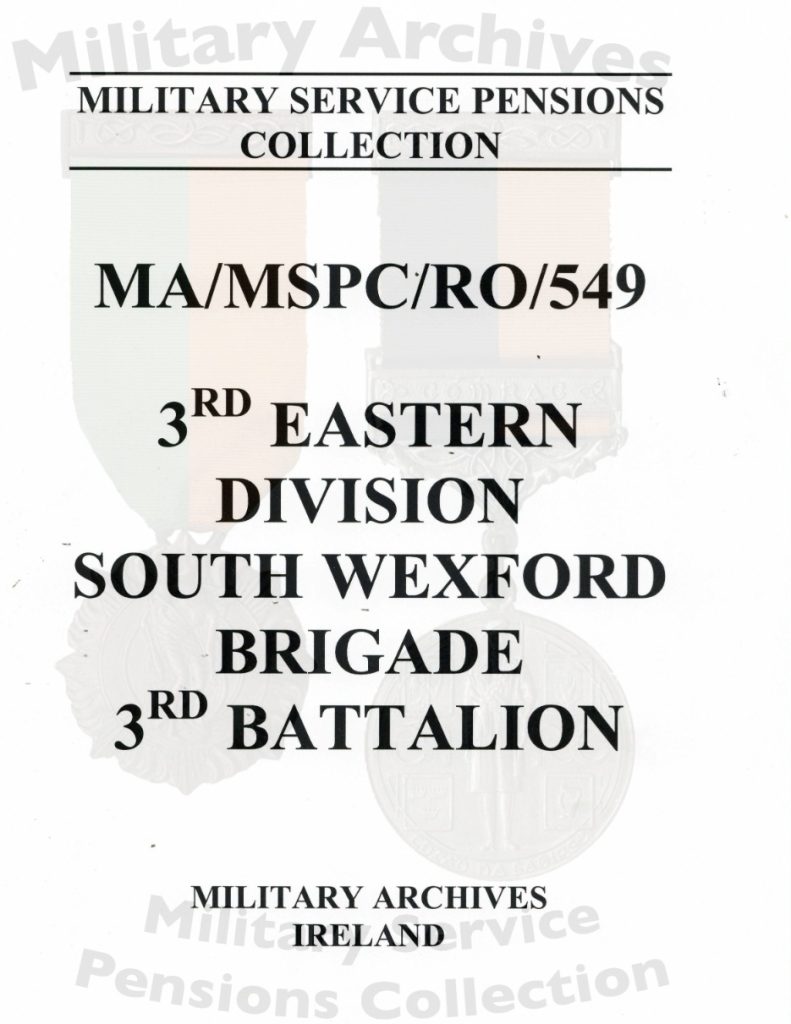
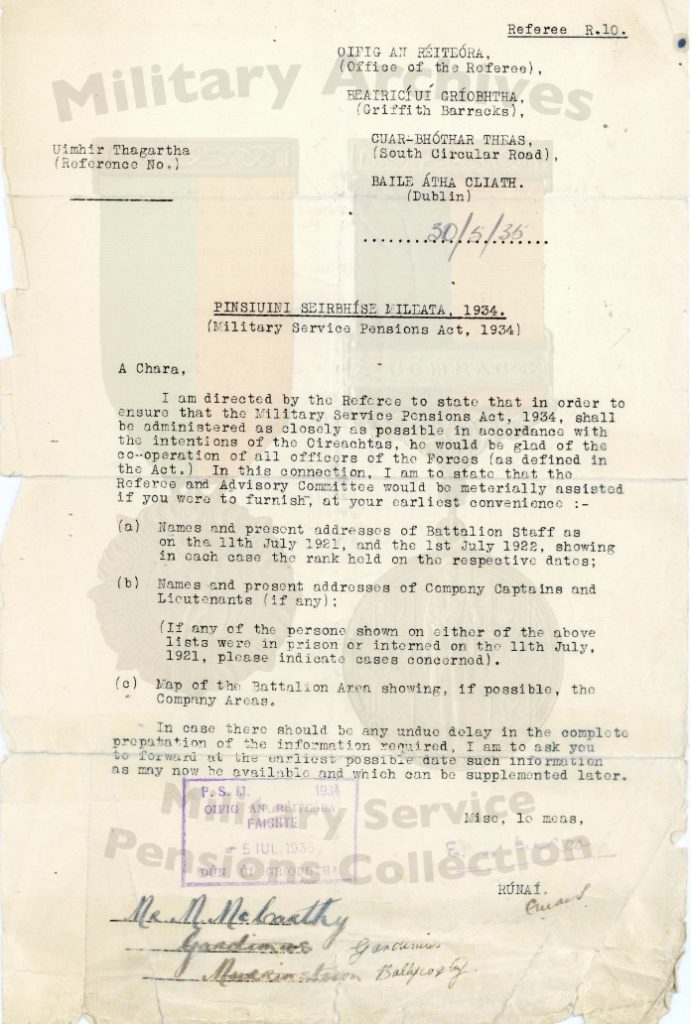
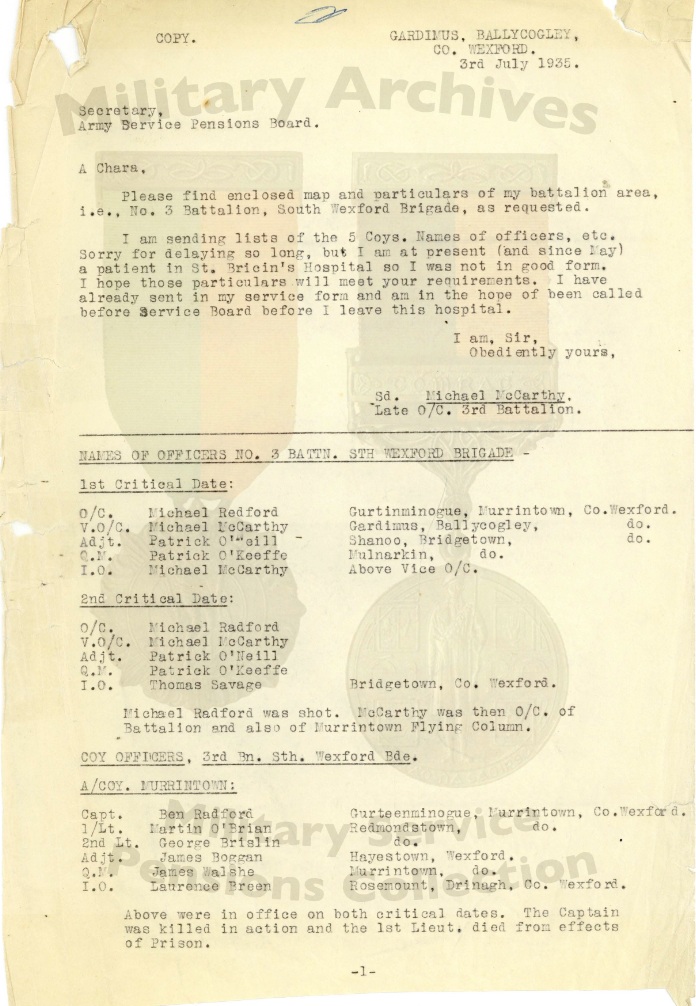
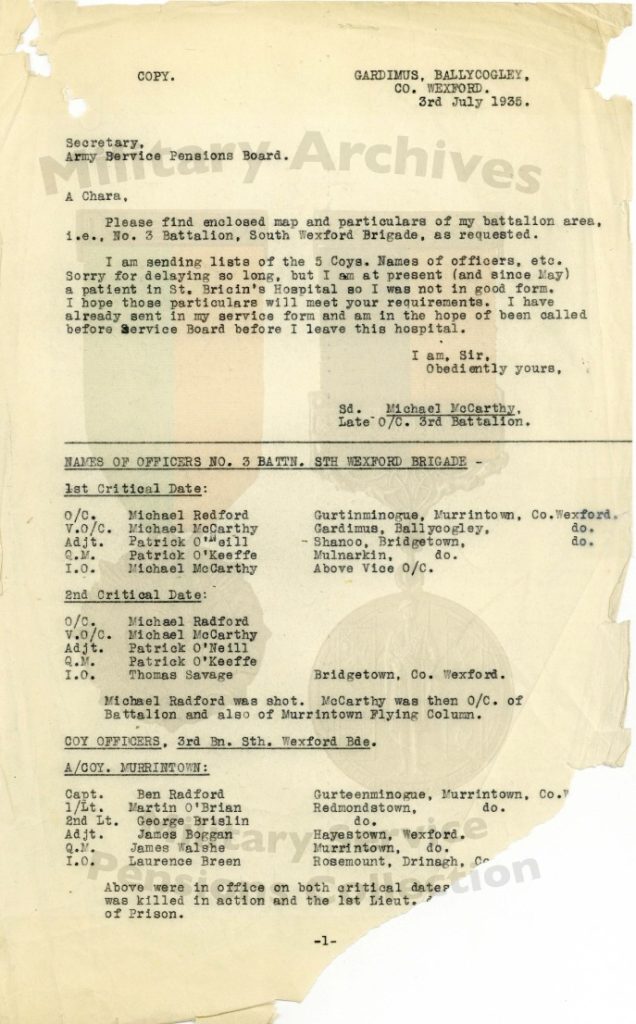

Timeline of Key Events in Michael McCarthy’s Military Career
- 1917–1920: McCarthy joins the Irish Volunteers/IRA in County Wexford during the War of Independence. By late 1920 the South Wexford Brigade is formed, and he becomes Adjutant then Vice-Commandant of the brigade’s 3rd Battalion (source) (source).
- July 1921: The Truce with Britain finds McCarthy serving as Vice O/C of the 3rd Battalion under Commandant Michael Radford. The battalion has about 159 members at this time (growing to over 300 by mid-1922) (source).
- June 1922: Outbreak of the Irish Civil War. McCarthy and most of the South Wexford IRA reject the Anglo-Irish Treaty and take the anti-Treaty side (source). He remains second-in-command of his battalion as IRA forces seize control of Wexford’s towns in early July 1922 (source).
- July 1922: Free State (National Army) columns recapture Enniscorthy, Wexford town, and New Ross within the first week of July, forcing McCarthy and the IRA to retreat and begin guerrilla warfare (source). On 24 July, McCarthy’s comrades in Lambert’s column ambush a troop train at Killurin, killing 3 National Army soldiers (source). McCarthy helps coordinate ongoing guerrilla operations through late 1922.
- Oct–Dec 1922: Intensification of the guerrilla campaign in South Wexford – attacks on rail lines, roads, and patrols continue (source). The National Army in Wexford struggles to contain the IRA. McCarthy is actively leading flying column activities of the 3rd Battalion during this period.
- Jan 1923: The 3rd Battalion’s Active Service Unit is ambushed at Spencerstown. McCarthy’s close comrade Bernard Radford and another Volunteer Cornelius “Con” McCarthy are killed in action (source). This is a major blow to McCarthy’s unit, which subsequently merges with another column to continue fighting.
- 13 March 1923: Free State forces execute three IRA prisoners from South Wexford (Parle, Creane, Hogan) in Wexford Jail (source). McCarthy’s battalion suffers from low morale and manpower as the war nears its end.
- Late April 1923: IRA Chief of Staff Frank Aiken calls a ceasefire and orders units to dump arms. McCarthy consents to the order; active operations in Wexford halt. In May or June 1923, his commanding officer Michael Radford is killed by Free State troops (source). McCarthy, now the senior officer, formally takes command of the 3rd Battalion as it disbands. He avoids execution or death, and is likely interned briefly before release in late 1923.
- 1935: Michael McCarthy applies for an Irish Military Service Pension. In a July 1935 letter from Gardamus, Ballycogley, he provides the Army Pensions Board with a detailed account of his service and confirms he was O/C of the 3rd Battalion, South Wexford Brigade by the end of the Civil War (source). He is living in Wexford and dealing with health issues (hospitalized) while pursuing his pension.
- Later Years: McCarthy lives out a quiet life in County Wexford. He receives a service pension for his contributions to Ireland’s independence struggle. His family and local historians preserve his memory. (Exact date of his death is not readily documented, but his legacy lives on through archival records and the genealogy of the McCarthy family.)
Sources: Irish Military Archives (Military Service Pensions Collection, Brigade Nominal Rolls)(source); The Past (Journal of the Uí Cinsealaigh Historical Society) – Aaron Ó Maonaigh, “Wexford’s Civil War Dead: A Statistical Survey” (source); University College Cork, Irish Civil War Fatalities Project (Wexford section) (source) (source); and local history works. These records and accounts provide a well-documented picture of Michael McCarthy’s life and military service in Co. Wexford.
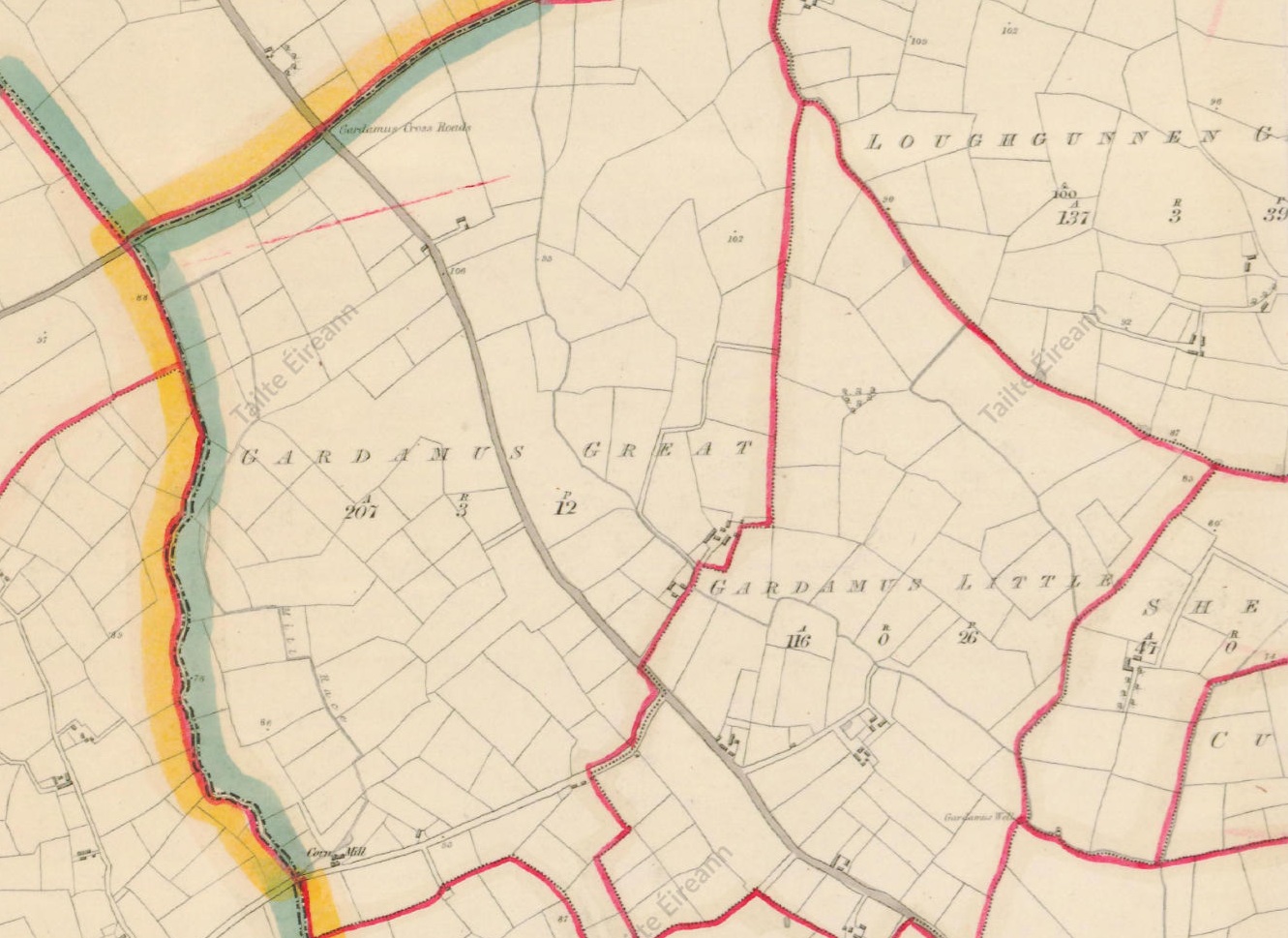
2 Comments
Very interesting
[…] To further establish connections or subsequent life events, we can look at military or pension records. Michael J. McCarthy, being of a younger generation, came of age around the time of World War I. It’s worth checking if he (or other members of the family) served in the military. Many Irishmen from Wexford joined the British forces in WWI. A search of military databases shows several “Michael McCarthy” entries – for example, a Private Michael McCarthy from Wexford served in the Royal Irish Regiment and died in 1915 (source), although it’s clear this was not the same individual as our Michael J. as he had a role to play in the Irish War of Independence and the subsequent Irish Civil war in South Wexford (source). […]